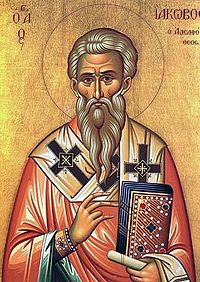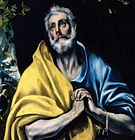The Incident at Antioch was an Apostolic Age dispute between the apostles Paul and Peter which occurred in the city of Antioch around the middle of the first century. The primary source for the incident is Paul's Epistle to the Galatians 2:11â€"14. Since Ferdinand Christian Baur, scholars have found evidence of conflict among the leaders of Early Christianity; for example James D. G. Dunn proposes that Peter was a "bridge-man" between the opposing views of Paul and James the Just. The final outcome of the incident remains uncertain resulting in several Christian views of the Old Covenant to this day.
Gentile Christians and the Torah

As Gentiles began to convert from Paganism to Christianity, a dispute arose among Christian leaders as to whether or not Gentiles needed to observe all the tenets of the Law of Moses. In particular, it was debated whether Gentile converts needed to be circumcised or observe the dietary laws; circumcision especially being considered repulsive in Hellenistic culture.
Probably completely independent of Paul (see Possible conversion of Gamaliel for a counterview) but around the same time period, the subject of Gentiles and the Torah was also debated among the rabbis as recorded in the Talmud. This resulted in the doctrine of the Seven Laws of Noah, to be followed by gentiles, as well as the determination that "gentiles may not be taught the Torah." The 18th-century Rabbi Jacob Emden was of the opinion that Jesus' original objective, and especially Paul's, was only to convert Gentiles to the Seven Laws of Noah while allowing Jews to follow full Mosaic Law. See also Dual covenant theology.
Paul was a strong advocate of the position that Gentiles need not be circumcised nor observe dietary laws, a position which some took to advocate Antinomianism. Others, sometimes termed Judaizers, felt that Gentile Christians needed to fully comply with the Law of Moses.
Council of Jerusalem
Paul left Antioch and traveled to Jerusalem to discuss his mission to the Gentiles with the Christian "pillars of authority." Describing the outcome of this meeting, Paul says "they recognized that I had been entrusted with the good-news for the un-circumcised." Acts of the Apostles describes the dispute as being resolved by Peter's speech and concluding with a decision by James the Just to not require circumcision from gentile converts. Acts quotes Peter and James as saying:
"My brothers, you are well aware that from early days God made his choice among you that through my mouth the Gentiles would hear the word of the gospel and believe. And God, who knows the heart, bore witness by granting them the Holy Spirit just as he did us. He made no distinction between us and them, for by faith he purified their hearts. Why, then, are you now putting God to the test by placing on the shoulders of the disciples a yoke that neither our ancestors nor we have been able to bear? On the contrary, we believe that we are saved through the grace of the Lord Jesus, in the same way as they."
"It is my judgment, therefore, that we should not make it difficult for the Gentiles who are turning to God. Instead we should write to them, telling them to abstain from food polluted by idols, from sexual immorality, from the meat of strangled animals and from blood."
This Apostolic Decree is still observed by the Eastern Orthodox Church.
However, the historical reliability of the Acts of the Apostles is disputed. See also Dual-covenant theology.
Incident
According to the Epistle to the Galatians chapter 2, Peter had traveled to Antioch and there was a dispute between him and Paul. The Epistle does not exactly say if this happened after the Council of Jerusalem or before it, but the incident is mentioned in Paul's letter as his next subject after describing a meeting in Jerusalem which scholars often consider to be the council. Galatians 2:11â€"13 says:
When Peter came to Antioch, I opposed him to his face, because he was clearly in the wrong. Before certain men came from James, he used to eat with the Gentiles. But when they arrived, he began to draw back and separate himself from the Gentiles because he was afraid of those who belonged to the circumcision group.
To Paul's dismay, the rest of the Jewish Christians in Antioch sided with Peter, including Paul's long-time associate Barnabas:
The rest of the Jews joined in this charade and even Barnabas was drawn into the hypocrisy.
The Acts of the Apostles relates a fallout between Paul and Barnabas soon after the Council of Jerusalem, but gives the reason as the fitness of John Mark to join Paul's mission (Acts 15:36â€"40). Acts also describes the time when Peter went to the house of a gentile. Acts 11:1â€"3 says:
The apostles and the believers throughout Judea heard that the Gentiles also had received the word of God. So when Peter went up to Jerusalem, the circumcised believers criticized him and said, "You went into the house of the uncircumcised and ate with them."
This is described as having happened before the death of King Herod (Agrippa) in 44 AD, and thus years before the Council of Jerusalem (dated c. 50). Acts is entirely silent about any confrontation between Peter and Paul, that or any other time.
There is some debate that the confrontation was actually not between Paul and Peter, the Apostle, but another one of the identified 70 disciples of the time with the same name as Peter. In 1708, a French Jesuit, Jean Hardouin wrote a dissertation that argues "Peter" was actually "another Peter", thus the emphasis of using the name Cephas (Aramaic for Peter).
Outcome
The final outcome of the incident remains uncertain; indeed the issue of Biblical law in Christianity remains disputed to this day. The Catholic Encyclopedia states: "St. Paul's account of the incident leaves no doubt that St. Peter saw the justice of the rebuke." In contrast, L. Michael White's From Jesus to Christianity states: "The blowup with Peter was a total failure of political bravado, and Paul soon left Antioch as persona non grata, never again to return."
According to church tradition, Peter and Paul taught together in Rome and founded Christianity in that city. Eusebius cites Dionysius, Bishop of Corinth as saying, "They taught together in like manner in Italy, and suffered martyrdom at the same time." This may indicate their reconciliation. In 2Â Peter 3:16, Paul's letters are referred to as "scripture", which indicates the respect the writer had for Paul's apostolic authority. However, some modern scholars regard the Second Epistle of Peter as pseudepigraphical.
See also

- Apostolic Age
- Feast of Saints Peter and Paul
- New Perspective on Paul
- Proselyte
References

- Dunn, James D.G. The Incident at Antioch (Gal 2:11â€"18) Journal for the Study of the New Testament 18, 1983, pg 95â€"122
- James D. G. Dunn Echoes of Intra-Jewish Polemic in Paul's Letter to the Galatians Journal of Biblical Literature, Vol. 112, No. 3 (Autumn, 1993), pp. 459â€"477
- James D. G. Dunn, Jesus, Paul and the Law, chapter 6: "The Incident at Antioch"[1]
- White, "From Jesus to Christianity"
- Moriyoshi Murayama, The incident at Antioch ; a social-scientific analysis of Galatians 2:11â€"14
External links

-  "Judaizers". Catholic Encyclopedia. New York: Robert Appleton Company. 1913. With subsection titled "The Incident at Antioch".
- Paul N. Tobin, The Incident at Antioch
- Jewish Encyclopedia: Saul of Tarsus: Paul's Opposition to the Law
